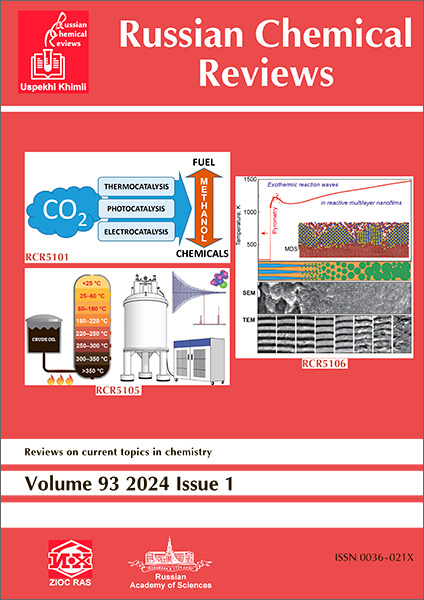Structural chemistry of host – guest molecular architectures based on mercury-containing macrocycles
IF 6
2区 化学
Q1 CHEMISTRY, MULTIDISCIPLINARY
引用次数: 0
Abstract
Metallomacrocycles that include several metal ions with the Lewis acid properties are peculiar antipodes of crown ethers (referred to as ‘anticrowns’ in the literature). Recently these architectures have been extensively investigated when searching for efficient and selective anion receptors. In this review, we analyze the data on the molecular and crystal structures of supramolecular complexes of mercury-containing macrocycles (hosts) with anions or neutral nucleophiles (guests). The emphasis is on the identification and systematization of the structure types of complexes in dependence of the guest molecule nature, as well as the macrocycle composition and structure. The factors affecting the selectivity of coordination and competitive ability of various electron donor moieties of guest molecules to binding to the macrocycle are considered. The data in the literature on the nonvalent host – guest and host – host interactions, which are responsible for the formation of molecular complexes and their supramolecular association in crystals, are analyzed. The formulated structural regularities of these coordination compounds with an unusual type of molecular architecture open ways to design directly promising molecular materials on their basis. The bibliography includes 161 references.基于含汞大环的主客体分子结构的结构化学
金属巨环包括几种具有路易斯酸性质的金属离子,是冠醚的特殊对映体(在文献中称为“反冠”)。近年来,在寻找高效和选择性阴离子受体时,这些结构得到了广泛的研究。本文分析了含汞大环(宿主)与阴离子或中性亲核试剂(客体)的超分子配合物的分子结构和晶体结构。重点是识别和系统的结构类型在依赖于客体分子性质,以及大环的组成和结构。考虑了影响客体分子的配位选择性和不同电子给体部分与大环结合的竞争能力的因素。本文分析了非价主-客体和主-宿主相互作用的文献数据,这些相互作用是晶体中分子复合物的形成及其超分子结合的原因。这些具有不同寻常分子结构的配位化合物的结构规律为在其基础上直接设计有前途的分子材料开辟了道路。参考书目包括161篇参考文献。
本文章由计算机程序翻译,如有差异,请以英文原文为准。
求助全文
约1分钟内获得全文
求助全文
来源期刊

Russian Chemical Reviews
化学-化学综合
CiteScore
13.00
自引率
5.20%
发文量
27
审稿时长
6-12 weeks
期刊介绍:
Russian Chemical Reviews serves as a complete translation of the esteemed monthly review journal Uspekhi Khimii, which has been a prominent figure in Russian scientific journals since its establishment in 1932. It offers comprehensive access to the advancements made by chemists from Russia and other former Soviet Union countries.
Established in 1932, Russian Chemical Reviews is committed to publishing timely and significant review articles encompassing various facets of modern chemistry, including chemical physics, physical chemistry, computational and theoretical chemistry, catalysis, coordination chemistry, analytical chemistry, organic, organometallic, and organoelement chemistry, chemistry of macromolecules, applied chemistry, biochemistry, bio-organic chemistry, biomolecular chemistry, medicinal chemistry, materials chemistry, nanochemistry, nanostructures, and environmental chemistry.
 求助内容:
求助内容: 应助结果提醒方式:
应助结果提醒方式:


